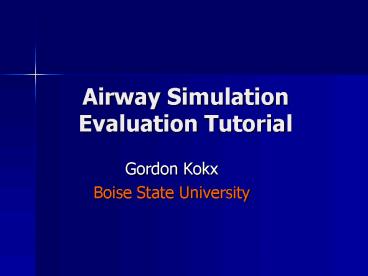Airway Simulation Evaluation Tutorial PowerPoint PPT Presentation
1 / 49
Title: Airway Simulation Evaluation Tutorial
1
Airway Simulation Evaluation Tutorial
- Gordon Kokx
- Boise State University
2
Purpose
- This project has been designed to evaluate the
efficacy of using a web-based venue to assist
paramedic instructors in their efforts to
successfully teach students endotracheal
intubation using high fidelity simulation. - The project will serve as the first phase of a
several phase venture that will eventually
provide research data to determine the use of
high fidelity simulation in achieving entry level
paramedic competency in the skill of endotracheal
intubation.
3
Instructional Design Model
- Analysis need for airway training
- Design web-based simulation project
- Development for EMS faculty and students
- Implementation pilot test with subject matter
expert feedback - Evaluation post use surveys and skill
evaluation instrument
4
Objectives
- At the completion of this training tutorial, the
participant will be able to - Develop an awareness of the integration of
simulation into teaching and evaluating
endotracheal intubation - Utilize the provided assessment instrument to
evaluate student skill performance - Provide feedback regarding the value of the
training module - Employ the web-based instructional model to
conduct future airway training
5
HIGH FIDELITY SIMUALTION ENDOTRACHEAL INTUBATION
EVALUATION REPORTING FORM
- 1. Recognizes indication for invasive airway
management (oxygen saturation lt85, respiratory
failure, or cardiac arrest) - 2. Steps in the endotracheal intubation (ETI)
attempt - 3. Patient scenario variables
- 4 Basic
- ?Noise
- ?Darkness
- ?In-line C-spine immobilization
- ?CPR (chest compressions)
- 3 Advanced
- Pharyngeal edema
- Cervical neck fusion
- Pharyngeal edema and cervical neck fusion
6
HIGH FIDELITY SIMUALTION ENDOTRACHEAL INTUBATION
EVALUATION REPORTING FORM
- 4. Patient subsets (Check if used)
- ECG monitor, Pulse-Oximetry, IV accesss
- C-spine immobilization, CPR (chest compressions)
- 5. Drugs used (if any) to facilitate intubation
- 6. Patient demographic information
- Why is intubation necessary? (including GCS)
- 7. Was attempt successful?
- 8. What was the final determination of the
placement (location) of ET tube? - 9. Vital signs after intubation attempt
- 10. If all intubation attempts FAILED, indicate
suspected reasons for failed intubation
7
HIGH FIDELITY SIMUALTION ENDOTRACHEAL INTUBATION
EVALUATION REPORTING FORM
- 11. Critical scenario chronology elements
- Time of decision to intubate
- Time of successful intubation
- Time intubation abandoned
- 12. Critical complications encountered during
airway management - Inability to recognize need for intubation
- Poor intubation technique
- Inability to manage scene
- Inability to direct other rescuers
- Lack of adequate preparation
- Failure to choose proper equipment
- 13. Glottic View (according to student)
- Full
- Partial
- None
- Laryngospasm
8
Steps of the procedure
- The following are critical steps of the training
procedure
9
Look, Listen and Feel for Airway
10
Don Body Substance Isolation
11
Perform Jaw Thrust
12
Place Oropharyngeal Airway
13
Provide BVM with Room Air
14
Provide BVM Ventilation with Supplemental 02
15
Check Laryngoscope
16
Check Pilot Balloon
17
Perform Sellick Maneuver
18
View Glottis and Cords
19
Place Tube
20
Remove Laryngoscope
21
Remove Stylet
22
Inflate Bulb Syringe
23
Ventilate via tube within 20 seconds of last
ventilation
24
Methods of tube confirmation
- Ventilation
- Auscultation
- Syringe
- Bulb Aspirator
- Colormetric End Tidal C02
25
Ventilation Observe Chest Rise
26
Auscultation
27
Syringe
28
Bulb Aspirator
29
End-tidal C02 Detection
30
Secure tube
31
Scenario Variables
- Room noise
- Cervical Neck Fusion
- Trismus
- Tongue Edema
- Pharyngeal Swelling
- Laryngospasm
32
Loud Television Noise
33
In-line Cervical Stabilization
34
Cervical Neck Fusion
35
Trismus
36
Tongue Edema
37
Pharyngeal Swelling
38
Laryngospasm
39
Perform CPR
40
Place Cardiac Monitor
41
Measure Pulse Oximetry
42
Common RSI Medications
43
Auscultate Blood Pressure
44
Rating Glottic Views
- None
- Partial
- Full
45
No Glottic View
46
Partial Glottic View
47
Full Glottic View
48
Summary of Objectives
- At the completion of this training tutorial, the
participant will be able to - Develop an awareness of the integration of
simulation into teaching and evaluating
endotracheal intubation - Utilize the provided assessment instrument to
evaluate student skill performance - Provide feedback regarding the value of the
training module - Employ the web-based instructional model to
conduct future airway training
49
Questions
- gkokx_at_csi.edu

